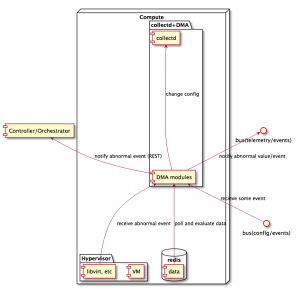...
One of the telecom requirement of fault management for NFV is high scalability monitoring and advanced analytics. Distributed Monitoring and Analytics is the framework for fault management (FM), the architecture of DMA is to integrate each function of FM into each computing node. These functions are collecting, storing, evaluating, analysing, etc. Current centralized monitoring framework is strong and stable, but not high scalability. Distribution approach for FM is one of the solution for NFV. Using DMA, you can get the high scalability monitoring and advanced analytics.
Architecture
TBA
Use cases
- For detecting silent failures
To detect micro burst traffic is little difficult using centralized monitoring, because you have to set monitoring interval very short and this setting is high load. In DMA, we verified that you can detect the micro burst traffic using collectd less load. - For advanced analytics
Using machine learning, you can easily analyse some abnormal behaviours of computing node. That is very helpful infrastructure operator and VNF operator. We verified using scikit-learn to detect some abnormal behaviours.
Both use cases, you can watch the demo at OpenStack Summit Sydney's video (https://www.openstack.org/videos/summits/sydney-2017/dmadistributed-monitoring-and-analysis-monitoring-practice-and-lifecycle-management-for-telecom)
Current status
You can use the local agent function as a DMA function that is changing collectd config static and annoation that is combining libvirt infomation and OpenStack information into the alret. That code is included Ganbia release. Manual is below link:
https://opnfv-barometer.readthedocs.io/en/stable-gambia/release/userguide/docker.userguide.html#build-and-run-localagent-and-redis-docker-imagesTBA
Components
local-agent
TBA
policy-agent
...
